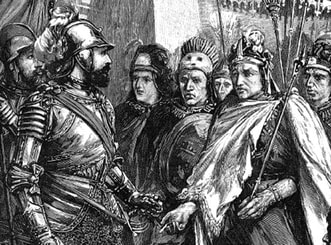Prelude to the fall of the Aztec Empire
On August 13, 1521, the Aztec empire of central México was defeated by an army made up mainly of Mesoamerican Indigenous people, and a group of approximately 500 Spaniards under the command of Captain Hernán Cortés. As a way to commemorate the 500th anniversary of the fall of the Aztec empire, Sol de Medianoche, with expert knowledge of Lorena Medina Martínez, archaeologist from the National School of Anthropology and History of Mexico and the University of Alaska Anchorage, will present the first of three articles to talk about this historical event. In the first article, we are addressing the arrival of the Spaniards to the mainland of present-day México, and their campaign throughout the Mesoamerican territory until they met Emperor Motecuhzoma Xocoyotzin in what is now the center of Mexico City.On October 12, 1492, Christopher Columbus, thinking that he had arrived in India, called the inhabitants of the islands of the Antilles “Indians”. What Christopher Columbus did not know is that it was not India but a group of islands in what we know today as the American continent. Once established in the Antilles, the Spanish wanted to continue exploring these territories. One of these Spaniards, Hernán Cortés left the island of Cuba with a group of Spaniards with the aforementioned objective of exploring more territories; thus, on February 10, 1519, this group of Spaniards arrived on the island of Cozumel located in the Mexican Caribbean. From Cozumel they began their journey following the coastline until they reached what is now known as the Mexican state of Veracruz. From Veracruz they advanced towards the center of Mexico to reach the capital of Mexico Tenochtitlan where the Aztec empire resided. During their journey, from Cozumel to Mexico Tenochtitlan they met different indigenous groups and learned about the political situation of the territory. It is noteworthy that during this journey the Spaniards established a communication system that was of great help in their objectives of reaching and dominating the territory. The group going to Mexico Tenochtitlan, included, Malintzin, also known as Marina, an indigenous woman, who became the translator and interpreter for the Mayan and Nahuatl languages, and who eventually learned Spanish. Also included was, a Spanish captive Jerónimo de Aguilar, who interpreted Mayan and Spanish. Thus, the language barrier was resolved by creating an effective communication system between the Nahuas of central Mexico and the Spaniards.
The domination of many of the Mesoamerican groups by the Aztecs, and the tax burdens in commodities and services, among other things, had the subject ethnic groups dissatisfied. This situation facilitated alliances among the Spanish newcomers under the command of Hernán Cortés and some of these Mesoamerican groups. Some of these groups were Tlaxcalans, Chalcas, Huejotzincas, and Texcocans, among others. Thus, with a certain level of knowledge about the Mesoamerican political, economic and social situation, Hernán Cortés and his indigenous allies reached the center of Mexico from the south, advancing along the Iztapalapa avenue on November 8, 1519. That day the Aztec emperor Motecuhzoma Xocoyotzin and the Spanish captain Hernán Cortés met for the first time, at the corner of present-day Pino Suarez and República del Salvador streets. After this first meeting in 1519, historical events transpired in which there were three positions to consider: one, the desire of the Spaniards to obtain territories, wealth and glory, which led them to visualize the strategies they would take to eventually achieve this appropriation; two, the position of the Aztec empire being aware of the Spaniards and their tactics to protect and defend not only the empire but their culture, language, history, beliefs, and territory; three, the situation of the thousands of indigenous allies who saw in this coalition with the Spaniards the opportunity to free themselves from the dominion that the Aztec empire had over them. |
